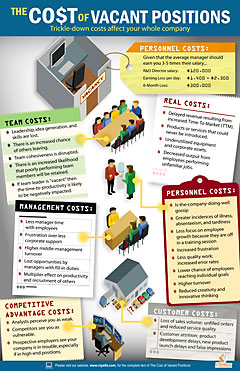 It’s 8 am Monday morning. Your R&D Director walks into your office and informs you that he’s resigning. To make matters worse, he’s leaving to take a position with one of your top competitors. You weren’t expecting this loss, but you’re able to keep things in perspective. Besides, this may be an ideal opportunity to reduce overhead and run on a leaner budget.
It’s 8 am Monday morning. Your R&D Director walks into your office and informs you that he’s resigning. To make matters worse, he’s leaving to take a position with one of your top competitors. You weren’t expecting this loss, but you’re able to keep things in perspective. Besides, this may be an ideal opportunity to reduce overhead and run on a leaner budget.
Perhaps, there is a hiring freeze in place or maybe you feel that refilling the position is of relatively low importance compared to everything else you have on your plate. In the meantime, you split the workload between your two remaining managers. They’re experienced, they have longevity, and they have a strong rapport with the staff. Overall, you think the decision will have a positive impact on your bottom line.
Individual Job Vacancy Cost versus Real Cost
At a first glance, it may appear that you’re making an intelligent decision. But before you go bragging to the executive team about your newfound efficiencies, consider the real cost of the job you’re leaving vacant.
That’s right, vacant jobs come with a cost, and there are two primary levels to consider when evaluating the cost of leaving a job unfilled: the individual job vacancy cost, and the total, or real cost.
Individual Job Vacancy Cost
According to chemical industry experts, the average manager should earn for their company anywhere from three to five times their annual salary. With the average salary for an experienced R&D Director at $175,000 annually, you could be looking at a loss of earnings potential between $3,100 and $4,000 per day by leaving a job unfilled. If the job sits vacant for six months, the loss skyrockets to around $700,000. While this is not a trivial figure, it only represents a small percentage of the total impact a job vacancy can have on your bottom line.

The Real Costs
In his article “Calculating the Cost of a Vacant Position,” HR guru Dr. John Sullivan outlines the real cost of job vacancies. Dr. Sullivan’s calculations take into account the trickle down effect that vacancies have on the rest of the organization. Don’t be fooled into believing that open positions cost you only some overtime. The truth is, vacancies can expose your organization to unforeseen and unacceptable expenses, including the following:
Revenue Costs
Loss of revenue is the most obvious and easily quantifiable cost associated with open positions:
- Delayed revenue resulting from longer Time-To-Market (TTM) for new products
- Lost revenue resulting from products/services that could never be introduced
- Underutilized equipment and corporate assets
- Decreased output because employees are performing unfamiliar jobs
Personnel Costs
Employees who remain in your organization are hurt by vacancies. The added workload and higher stress levels can result in a number of problems:
- Sends a message to employees that the company isn’t performing well
- Greater incidences of illness, absenteeism, and tardiness
- Decreased opportunity to focus on the growth of the current employees by sending them to development programs and training seminars
- Increased frustration
- Increased scrap and rework/error rates
- Lower chance of employees reaching individual goals
- Higher turnover
- Reduced creativity and innovative thinking
Team Costs
Open positions can also cost your work teams:
- Lost leadership, idea generation, and skills of the vacated person
- Increased chance that other members will leave
- Disruption in team cohesiveness/morale
- Increased likelihood that poorly performing team members will be retained
- If the team leader is the "vacancy" then "time to productivity" is likely to be even more negatively impacted
Management Costs
Managers in charge of departments with open positions must contend with a number of headaches:
- Increased opportunity costs because managers have to spend valuable time performing fill-in duties
- Less time to manage remaining employees
- Increased frustration over lack of corporate support
- Higher turnover in middle management (and often in senior management)
- Vacancies in management and team leader positions have a multiplier effect on the decrease in productivity and the recruitment of others.
Customer Costs
Vacancies in critical areas can affect customer satisfaction levels, sometimes with serious consequences:
- Loss of sales volume because of inability to fill orders in a timely manner
- Loss of sales volume because of reduced service quality
- Increased customer attrition due to delays in new product launches that cause customers to look for alternative suppliers.
- Increased customer perception that you are getting weak or do not care about their business
Competitive Advantage Costs
Open positions can affect your ability to remain competitive in the marketplace:
- Sends a message to analysts that you are weak
- Sends a message to competitors that you are vulnerable
- Sends a message to prospective employees that the company is in trouble (this problem can be especially acute for high-demand positions)
- Causes resources to be underutilized
- Erodes your corporate culture
- Vacancies at the CEO, CFO, CTO, and other top manager positions can have an adverse impact on financing and the willingness of others to partner with you
Be Proactive
Don’t let your organization fall victim to the “we’ll just make do” attitude. While there are certainly times when it makes sense to let attrition reduce your workforce, be sure to thoroughly evaluate the risks and consequences of vacancies before making your decisions.
And when you do need to hire, be sure to design a plan to minimize the probability of future vacancies. Start by hiring people with the skills and temperament to succeed in your organization. Then make sure you keep these valuable employees satisfied and happy to be working for you. Yes, there are costs involved in developing well-functioning hiring and retention procedures. But the time and money you spend will be far less than the alternative.




